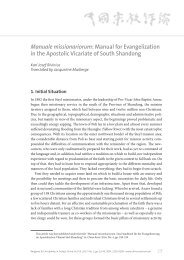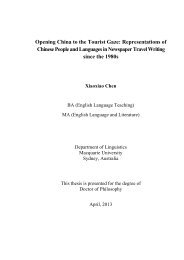EDUCATION IN CHINA
Education-in-China-a-snapshot
Education-in-China-a-snapshot
You also want an ePaper? Increase the reach of your titles
YUMPU automatically turns print PDFs into web optimized ePapers that Google loves.
Chapter 6 – Guangdong<br />
Spurring education development in Shenzhen<br />
SHENZHEN SPECIAL DISTRICT<br />
Shenzhen gives observers a window into the reform and<br />
opening up of China. Shenzhen has experienced a rapid<br />
transformation from a fishing-town to an international<br />
city in recent decades. Situated immediately north of<br />
Hong Kong, Shenzhen became the first and the most<br />
successful special economic zone in China. It currently<br />
also holds sub-provincial administrative status, and has<br />
slightly less power than a province. As stated earlier,<br />
Beijing, Shanghai, Guangzhou and Shenzhen are the four<br />
major cities in China.<br />
CATCH<strong>IN</strong>G UP WITH HONG KONG <strong>IN</strong><br />
ECONOMIC GROWTH AND <strong>EDUCATION</strong><br />
Shenzhen is a major financial centre in southern China.<br />
The city is home to the Shenzhen Stock Exchange as well<br />
as the headquarters of numerous high-tech companies.<br />
It was dubbed China’s Silicon Valley due to this high<br />
concentration of technology companies. It is the picture<br />
of a modern city, with a gleaming, tower-filled skyline.<br />
Thus it is hard to imagine that before 1979, Shenzhen<br />
was a fish market town. The fast development of the city<br />
is the result of a vibrant economy made possible by rapid<br />
foreign investment that began with reform and opening<br />
policies and the establishment of the special economic<br />
zone.<br />
TABLE 6.1 BASIC STATISTICS FOR SHENZHEN AND HONG KONG<br />
City name<br />
Area<br />
(km 2 )<br />
Population<br />
(2014 in million)<br />
GDP<br />
(2014 in billion<br />
US dollars)<br />
GDP per capita<br />
(2014 in US dollars)<br />
GDP increasing<br />
rate (2014)<br />
Shenzhen 1 997 10.8 257.8 24 336 8.8%<br />
Hong Kong 1 104 7.3 289.2 39 900 5.5% (or 2.5%)<br />
Source: Census and Statistics Department of Hong Kong, China 2015; Shenzhen Bureau of Statistics, 2015.<br />
Currently, Shenzhen continues to develop at a brisk<br />
rate, despite the fact that development in the rest of the<br />
country slowed down of late. Hot Spots, an Economist<br />
Intelligence Unit (EIU) research programme commissioned<br />
by Citigroup, ranked Shenzhen as second in economic<br />
strength among the 120 the world’s major cities (EIU,<br />
2012). As shown in Table 6.1, Shenzhen is catching<br />
up with the city of Hong Kong, in terms of economies<br />
experiencing rapid growth. Because living expenses are<br />
lower in Shenzhen, the two cities are competitive. In 2015,<br />
for the first time in a decade, the city of Hong Kong has<br />
been unseated as the most competitive city in China in<br />
the China Blue Book on Urban Competitiveness, according<br />
to the Chinese Academy of Social Sciences (2015), which<br />
placed Shenzhen in the top spot.<br />
first city to get the Certificate of Equitable Development<br />
in Compulsory Education. Many famous universities<br />
have graduate schools or research centres in Shenzhen.<br />
The Chinese University of Hong Kong, Shenzhen, was<br />
founded on 11 October 2012 and approved by the Ministry<br />
of Education of China on 16 April 2014 (Education News,<br />
2014). The Chinese University of Hong Kong chose<br />
Shenzhen for the location of its first campus outside<br />
Hong Kong for two reasons: 1) Shenzhen needed to<br />
improve its competitiveness in post-secondary education;<br />
and 2) Shenzhen is the neighbour of Hong Kong, which<br />
makes it easier for the new campus to share resources<br />
with the main campus in Sha Tin, Hong Kong.<br />
Shenzhen has also developed its education system,<br />
especially its higher education system. Shenzhen is the<br />
54 – <strong>EDUCATION</strong> <strong>IN</strong> CH<strong>IN</strong>A: A SNAPSHOT © OECD 2016





